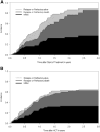Allogeneic hematopoietic cell transplantation in patients age 60-70 years with de novo high-risk myelodysplastic syndrome or secondary acute myelogenous leukemia: comparison with patients lacking donors who received azacitidine
- PMID: 22579634
- PMCID: PMC4560484
- DOI: 10.1016/j.bbmt.2012.05.003
Allogeneic hematopoietic cell transplantation in patients age 60-70 years with de novo high-risk myelodysplastic syndrome or secondary acute myelogenous leukemia: comparison with patients lacking donors who received azacitidine
Abstract
Standard first-line therapy for older patients with high-risk myelodysplastic syndrome (MDS) includes hypomethylating agents, such as azacitidine (AZA). However, the only approach with curative potential remains allogeneic hematopoietic cell transplantation (HCT). To date, no direct comparison of both strategies has been reported. The outcomes of 2 well-balanced cohorts of patients with high-risk MDS defined by age (60-70 years), performance status (Eastern Cooperative Oncology Group score ≤2), and donor availability (yes/no) were compared, including 103 patients undergoing HCT and 75 patients without this option who received AZA. The estimated 2-year overall survival after the start of treatment was 39% (95% confidence interval, 30%-50%) for the patients undergoing HCT and 23% (95% confidence interval, 14%-40%) for the patients receiving AZA therapy. In a multivariate Cox regression analysis of all patients (n = 178), Eastern Cooperative Oncology Group score (0 versus 1 versus 2; hazard ratio [HR], 2.9/3.9; P < .001), cytogenetics (good versus intermediate versus poor; HR, 1.2/1.7; P = .026), and treatment (HCT versus AZA; HR, 0.3; P = .007) were associated with overall survival. This retrospective cohort analysis suggests a survival advantage for allogeneic HCT compared with AZA therapy in medically fit patients with high-risk MDS age 60-70 years. Prospective controlled studies are warranted.
Copyright © 2012 American Society for Blood and Marrow Transplantation. Published by Elsevier Inc. All rights reserved.
Figures


Comment in
-
Transplantation for MDS in the elderly: more evidence, or more bias?Biol Blood Marrow Transplant. 2012 Sep;18(9):1320-1. doi: 10.1016/j.bbmt.2012.06.009. Epub 2012 Jun 29. Biol Blood Marrow Transplant. 2012. PMID: 22750646 No abstract available.
References
-
- Greenberg P, Cox C, LeBeau MM, et al. International scoring system for evaluating prognosis in myelodysplastic syndromes. Blood. 1997;89:2079–2088. - PubMed
-
- Deeg HJ. Optimization of Transplant Regimens for Patients with Myelodysplastic Syndrome (MDS) Hematology Am Soc Hematol Educ Program. 2005:167–173. - PubMed
-
- Sockel K, Hofbauer LC, Ehninger G, Platzbecker U. Optimizing outcome of MDS patients post transplantation. Expert Reviews in Hematology. 2011;11:12–18. - PubMed
-
- Bertz H, Potthoff K, Finke J. Allogeneic stem-cell transplantation from related and unrelated donors in older patients with myeloid leukemia. J Clin Oncol. 2003;21:1480–1484. - PubMed
Publication types
MeSH terms
Substances
Grants and funding
LinkOut - more resources
Full Text Sources
Medical
Research Materials
Miscellaneous

